Conservative Energy Policies Can Help Young People, Low-Income, and Minority Households Far More Than Liberal Ones
Liberal renewable energy advocacy groups like Fresh Energy and the Minnesota Center for Environmental Advocacy (MCEA) have devoted significant resources to the concepts of energy equity and fighting for environmental justice, which are supposedly designed to help low-income families, many of whom are minorities. However, by advocating for policies that make energy more expensive, these groups are hurting the people they are supposedly trying to help.
Conservatives can do far more good, for far more people, by strongly advocating for free-market policies that keep energy costs low for everyone.
Energy Burdened Households
According to the American Council for an Energy Efficient Economy, the energy burden of a household is the percentage of its income spent on energy. By this definition, it follows that low-income households pay a larger share of their income in energy bills than households with higher incomes.
As a result, it’s no surprise that low-income households, which often include young people, single-parent households, and minority households, are harmed the most by rising energy prices.
According to National Public Radio (NPR), the median black family in the Twin Cities area earns $38,178 a year , which is less than half of the median white family income of $84,459 a year. Households comprised of people under the age of 25 earned $36,440 in 2018. This means the liberal energy policies enacted in Minnesota harm these demographics far more than any other group.
Liberal Policies Bring Rising Prices
It is well documented that Minnesota’s electricity prices have been skyrocketing since the state passed its renewable energy mandate into law in 2007. Since that time, electricity prices have increased nearly 30 percent faster than the national average, and electric bills increased by $17.21 per month from 2005 (when Xcel was required to install wind turbines in order to extend the lives of their nuclear power plants, and 2018, as you can see in the graph below.
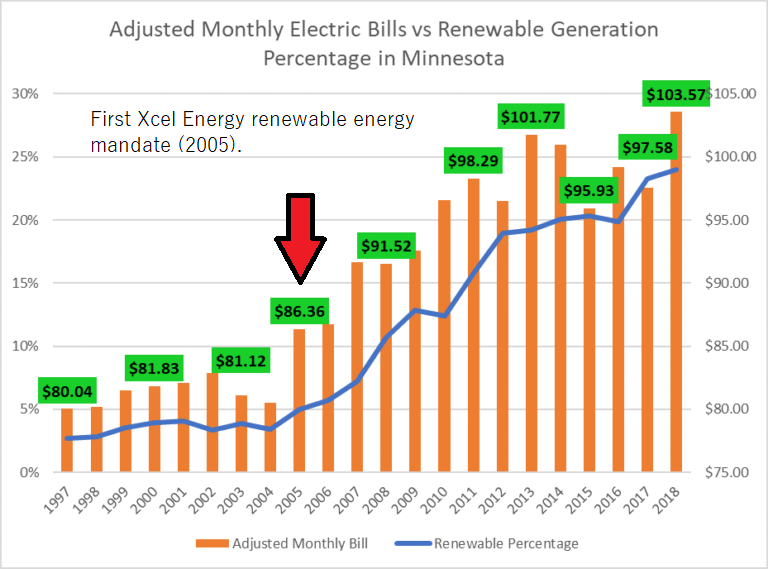
This results in the average Minnesota family paying an extra $200 per year (in $2018) in electricity costs, even though federal data shows these households use less electricity today than they did in 2005.
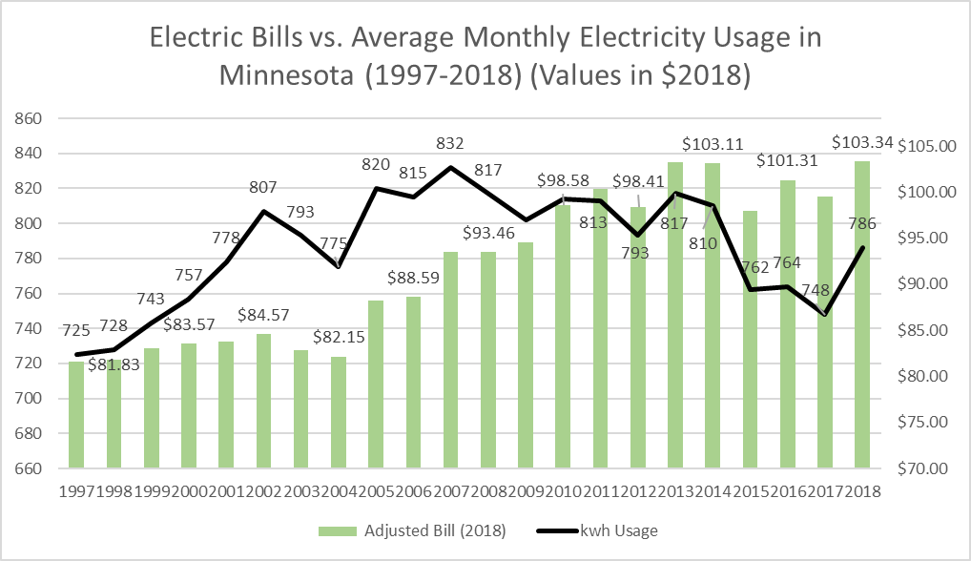
Liberal energy groups often claim that high energy burdens for low income households can be reduced by increasing spending on energy efficiency, thus reducing energy consumption.
But groups that make this claim are actually lying to consumers, because if Minnesota families reduce the amount of electricity they purchase, electric companies like Xcel Energy will simply raise the cost of electricity to make up the difference, as Mike Hughlett notes in the Minneapolis Star Tribune:
“Contributing to Xcel’s rate plea is an issue facing many utilities: falling electricity sales (by volume) as customers use less power.
Similar to our last two rate cases, declining sales necessarily mean that we must recover our investment over fewer units of sales,” Xcel said in a PUC filing.”
In the end, energy efficiency will not save consumers money because Xcel will simply charge them more for the electricity they still use. In the end, Xcel always wins, and consumers always lose.
Things Will Get Worse
On top of already-rising costs, Xcel’s proposal to close their coal plants before the end of their useful lifetime and replace this generation capacity with massive investments in solar, wind, and natural gas, will cause electricity prices to rise even more. Mitch Rolling ran the numbers on Xcel’s preferred plan (prior to their recent revisions) will increase the average cost of electricity in Minnesota by at least 20 percent by 2034, as you can see in the graph below.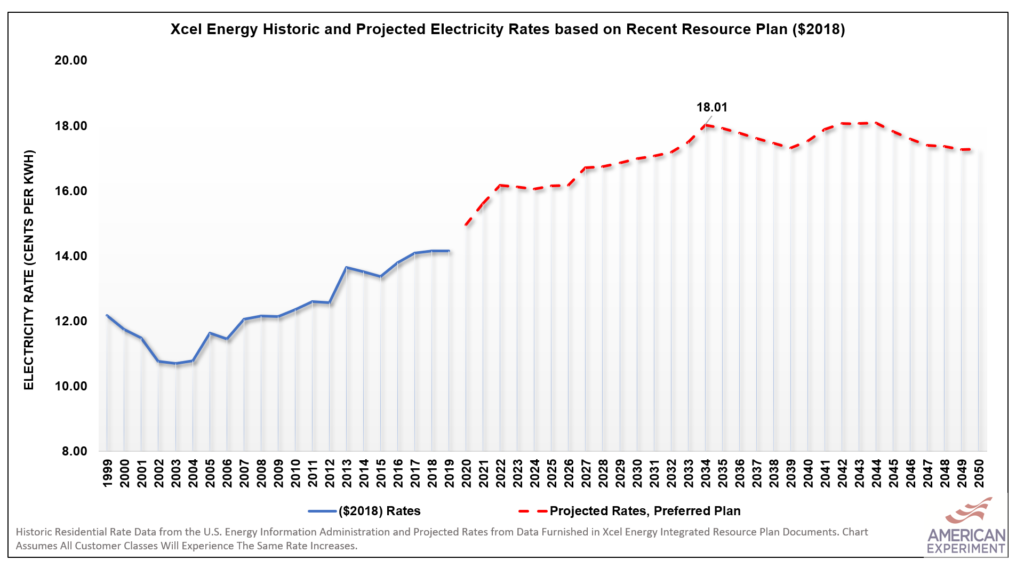
As a result, Minnesotan’s would see their electric bill increase by approximately $25 per month, or $300 per year by 2034.
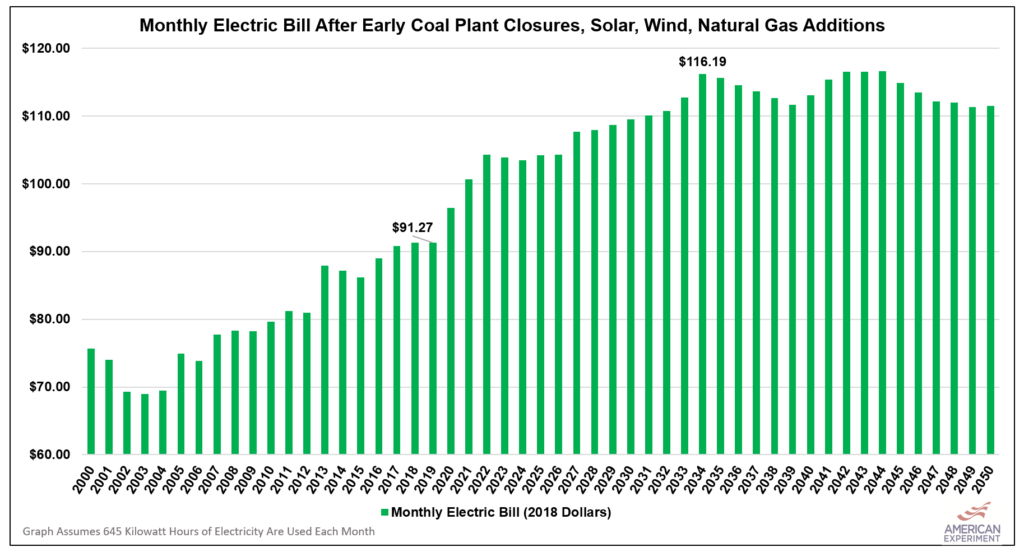
This brings the total additional cost of electricity for the average Minnesota electric bills to an additional $500 per year, in 2018 dollars, compared to 2005. This represents an additional energy burden of 1.3 percent for the average Black household in Minnesota, whereas it is only a 0.59 percent increase for the average white family.
We also believe these cost estimates for Minnesota families are extremely conservative, because we assume the energy burden of higher electricity prices is spread evenly among all customer classes (residential, commercial, industrial) when in reality this is almost never the case. In the real world, rate increases are disproportionately foisted upon residential customers, meaning the energy burden resulting from liberal energy policies will likely be much higher for low-income households than we have indicated above.
Conservative Energy Policies Help Everyone, But Low-Income Household Benefit Most
In contrast, conservative policies designed to lower energy costs help everyone, but they actually serve to help low-income household the most by lowering their energy burden to a greater degree than they would for higher income household.
For example, banning fracking, which is used to produce the natural gas that serves at the primary heating fuel in Minnesota, is one of the key platforms of liberal environmental groups around the country. According to a report by the U.S. Chamber of Commerce, this would cause natural gas prices to increase significantly, rising from $1.80 per thousand cubic feet (MCF) today, to $12 per MCF, which is 6.66 times higher than its current price.
Minnesota residential natural gas prices spiked at $14.80 per thousand cubic feet (TF) in 2007, but increasing production from fracking operations reduce prices to just $8.62 per TCF in 2018. These lower prices resulted in huge savings for Minnesota families.
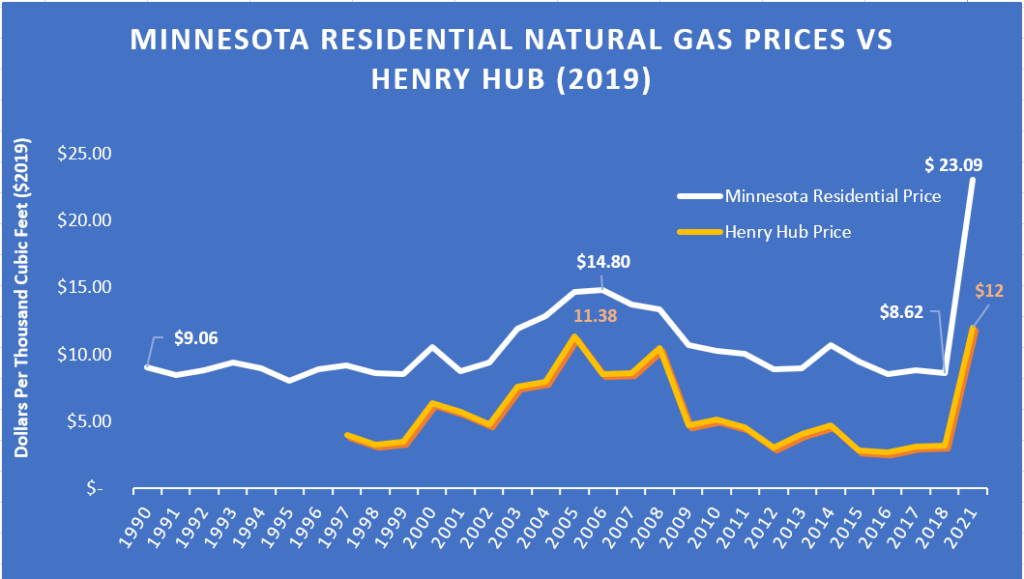
From 2007 to 2018, the average yearly natural gas costs fell from $1,324 to $790, representing a savings of $534 per household. This brought the average home heating energy burden of the average Black household in Minnesota down from 3.5 percent of annual household income, to just 2.06 percent of annual household income, falling nearly 1.5 percentage points.
In contrast, falling natural gas prices reduced the average white households home heating energy burden from 1.57 percent, down to 0.94 percent, a decrease of only 0.63 percent.

Now, if fracking were banned, and the Chamber of Commerce’s estimates for the cost of gas are correct, we can estimate the home heating costs for the average Minnesota household would increase to $2,115 per year. This would force the average Black family to pay 5.5 percent of their total income to heat their home during winter months, whereas the average white family would pay just 2.5 percent of their income for home heating.
Conclusion
Conservative energy policies can help low-income households by the most because reducing the cost of energy disproportionately benefits those with the least extra income to spare. Despite the focus of liberal groups on energy equity, the policies they advocate for make energy more expensive and thus make the energy burden experienced by low-income, minority families even worse.